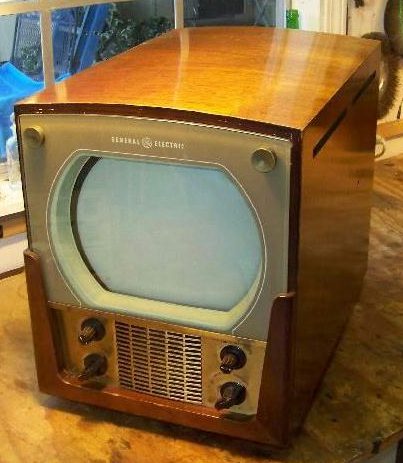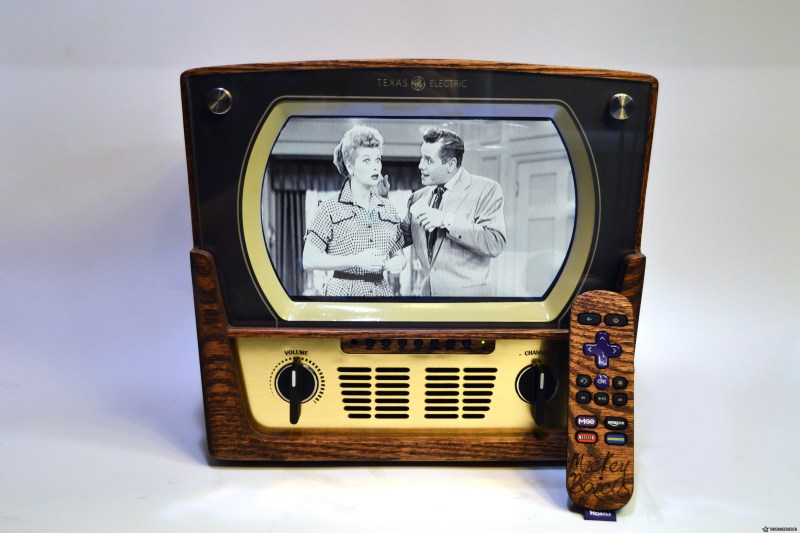Refits of retro TVs and radios with the latest smart guts are a dime a dozen around Hackaday. And while a lot of these projects show a great deal of skill and respect for the original device, there’s something slightly sacrilegious about gutting an appliance that someone shelled out a huge portion of their paycheck to buy in the middle of the last century. That’s why this all-new retro-style case for a smart TV makes us smile.

Another reason to smile is the attention to detail paid by [ThrowingChicken]. His inspiration came from a GE 806 TV from the 1940s, and while his build isn’t an exact replica, we think he captured the spirit of the original perfectly. From the curved top to the deep rectangular bezel, the details really make this a special build. One may quibble about not using brass for the grille like the original and going with oak rather than mahogany. In the end though, you need to work with the materials and tooling you have. Besides, we think the laser cut birch ply grille is pretty snazzy. Don’t forget the pressure-formed acrylic dome over the screen – here’s hoping that our recent piece on pressure-forming helped inspire that nice little touch.
This project was clearly a labor of love – witness the bloodshed after a tangle with a tablesaw while building the matching remote – and brought some life to an otherwise soulless chunk of mass-produced electronics.
[via r/DIY]
















Well done, Love the details of this project
The TV simply looks brilliant, But in my humble opinion, the remote is overdoing the woodgraining.
Yes, the remote would be big and clunky, and maybe attached to the set with a cable.
Michael
Would be nice to do something about the buttons, change them to more authentic old-fashioned ones, or maybe form a panel out of a sheet of metal or something. The remote doesn’t look authentic, doesn’t really look like anything.
Still it’s not supposed to be a work of art. The TV is still a nice piece of work. Turning the screen non-flat is a nice bit of extra detail.
I read that the early ultrasonic remotes were completely mechanical. No batteries, no electronics at all. Just a button mechanism that hits one of four (I think) little tuning forks, which the TV picks up. Presumably through reed relays tuned to resonate at the frequency. Stories abound among the old guys, of dogs with chain collars causing the channels to keep changing.
Am I really that old? Guess so! I remember in 1970s or early 80s UK we had one of the first tellies with a ‘pinger’ remote control channel-changer, as you describe. Pressing the large rocker-switch-type button loaded up some sort of spring plunger mechanism that suddenly whacked an ultrasonic sounder thing inside (I guess) and made the telly change channel. And yes, the telly would change channels with other loud ultrasonics, including jangly keys. I heard that even earlier versions would change channels whenever a neighbour pinged, creating the first ever ping-wars (about the same time as Pong came out, as I recall). Thanks for the memory-jog Greenaum!
Ultrasonic remotes first appeared in the States in the mid ’50s it seems.
https://web.archive.org/web/20080116212531/http://www.zenith.com/sub_about/about_remote.html
Yea, this TV is really a work of art but the remote just doesn’t cut it, he should have made it look like old remotes, like the ones here…
http://www.tvhistory.tv/Remote%20Controls.htm
Still, that TV, wow!
Now get a cheap microwave and Put the coil in the back of this to simulate the Radiation of the old Tubes
Wrong type of radiation. You want to take an old medical xray apart for that.
Brilliantly conceived and executed. I can relate to the emergency room episode. Late-night testing of a fairly powerful outrunner BLDC motor–essentially a blender on a stick. Index finger slipped, and the project cost went from <$100 to $3,500. Be careful around table saws and motors, folks. And all the other obvious dangers.
Absolutely fantastic!
Incredible project, but I have to wonder if the cost of a fresh saw blade might have saved him the cost of the ER visit. It might have also reduced the need for wood filler…
The build process is really good to read: such amazing attention to detail and getting it right.
And then I get to the bit where the Roku is held down with a bent piece of delrin and a couple of tek screws. Not too tidy considering the rest of it is so nicely made.
And THEN I see the picture of the two ‘transformers’ bound up with electrical insulation tape to hold them the the extension cord! What!
To go from doing such an exquisite job, with laser cutting the plastic and detailed woodwork, to that sort of low-down hack! I went from being impressed to being turned right off.
Shees Dan making light of a workshop accident after previously be moaning the fate of inanimate objects when people sometimes re-purpose older consumer electronics cabinets. I’m surprise the doctor allowed him to keep the stitch kit. Hospitals still sanitize and repackage the tools for reuse.
I may be an aspect ratio snob, but that totally kills it for me, doesn’t look correct. Worse than the rokumote does, you technically don’t even need to see the remote once its playing, but the widescreen is always there.